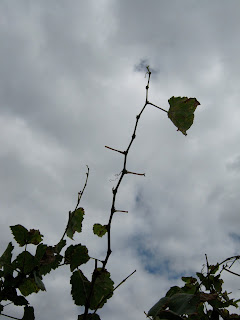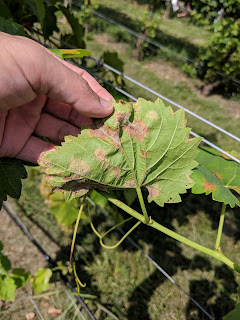At Winchester, the night time relative humidity has been still very high, close to 100%, in nearly every nights in the past three weeks. In addition, we have been observing rapid development of thunderstorms, pretty much every day in the past few days. I know I sound like a broken record, but these conditions favor downy mildew development because downy mildew pathogen prefers to produce spores under dark, humid conditions. Then spores will be spread via rain.
At this point, you do not need to worry about downy mildew infection on clusters; however, they can still infect leaves. Often time, you will initially see infection on the top of the canopy because younger leaves are more susceptible than older ones. Losing the top leaves and laterals are not a big deal; however, once the infection gets severe, it can defoliate many leaves rather quickly (as in the picture above), and that can affect maturing process. Knowing how wet this year has been, it is probably wise to be proactive on downy mildew management.
As usual, it is much better and easier to have a preventative program than trying to play the catch-up game. There are many good protective materials for downy mildew, such as Revus products, Zampro, Forum (Please note that these three share the same mode of action (FRAC=45 (+ 40 for Zampro), and Ranman (FRAC=21). In our small trial, fixed copper (FRAC=M1) worked pretty well against downy mildew when we compared with captan (FRAC=M4). Captan worked too, but a fixed copper product lasted longer than captan. However, some wine makers do not like to see captan or copper used late in the season, so, this time of the season maybe the best timing to use copper and captan for downy mildew. You can also use a phosphorous acid product (FRAC=33) as well (watch out for the rate!). For some cultivars, you may still use zirum (FRAC=M3) which has a 21-day PHI. Please mix and match to rotate among mode of action groups.
Downy is not the only disease you need to consider. The risk of Botrytis outbreak can be high with all the moisture in the air. Typically, I post end-of-the-season application tips in September, but it looks like the season is going much faster than a typical year for many of us. Thus, here is a list of fungicides with relatively short PHI (7 days or less) (a PDF file to download). I cannot cover every single fungicide out there, but I tried to cover common ones. Wine making considerations can influence fungicide uses close to the harvest too. Make sure to communicate with your wine maker(s) if they have a preference on the use of fungicides, especially copper and captan (I listed several copper materials because they have different PHI or REI.)
As I noted in one of previous posts, make sure to rotate mode of action for Botrytis because Botrytis pathogen is known for quickly developing fungicide resistance. I prefer to see a mode of action to be used twice or less per season, especially when we deal with Botrytis (with an exception of fungicides with FRAC code starting with “M”). Once again, wound management is very important to reduce the risk of Botrytis. Managing the source of wounds such as insects (esp. grape berry moth), or birds, or powdery mildew at early in the season, can positively impact Botrytis management. Also I should note that sour rot pathogens also going after wounds.








